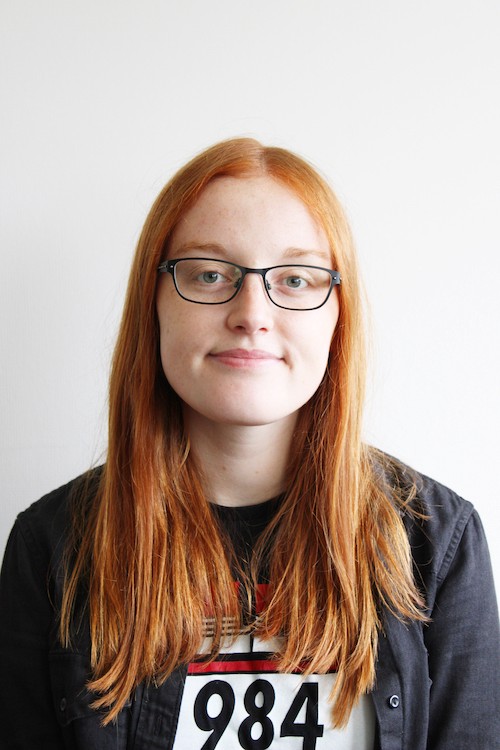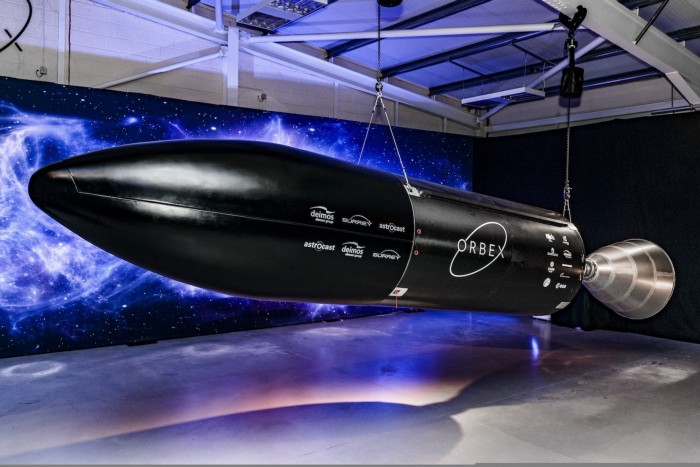Using her Graphic Communication (now Graphic Design) degree, Emily creates graphics across the company — from the main logo which features on the side of its rockets, to all its collateral marketing material and she was even involved in the redesign of the company’s staff café area.
We caught up with Emily to find out how she became involved in the space industry, and how her UCA degree has helped her reach her full potential.

Hi Emily! Thanks for chatting with us. So, tell us about where you work?
“I work for Surrey Satellite Technology Ltd. We design, build, test and launch satellites. I have been at the company since July 2017, so just over three years now. Our company has 350 employees across two sites in the South-east of the UK and has built and launched around 70 satellites for 22 countries so far.”
Was space ever a subject of interest to you before you got the job?
“I think I was only ever interested in space from an art perspective. I never got to grips with science at school and certainly never thought I’d have a job within the industry!
“I had the misconception (as do many others) that to work in the space industry you have to have a very scientific or academic-based background and that you have to go into engineering. In fact, there is a range of roles within the industry and it is really growing.
“I have definitely learned more about space and physics on the job than I ever did in school. Space engineers are the most fascinating people I have ever met. Their knowledge knows no bounds and they impart their wisdom through company talks and just chatting over lunch, which is amazing.”
Tell us about your UCA experience. What did you learn, over and above what you expected?
“I studied at the Farnham campus and graduated in 2016. On the course, I felt free to experiment across different media types which helped me hone my skills and understand what I might want to specialise in. I also learned a lot about the fundamentals of design and design theory. Having this mix of practical, contextual and theoretical teaching really laid the foundations to becoming an informed and well-rounded designer.
“I honestly loved my time at UCA. It sounds like a cliché, but I felt like a name and not a number. My course leader, lecturers and tutors all took the time to get to know me and my year group. They knew each of our strengths and worked hard to get the very best out of us. I made friends for life who are as passionate about design as I am and I’m so grateful to have had the opportunity to get to know them.”
How did it prepare you for the career you have today?
“I think studying and creating every day in a studio setting was really helpful and this soon felt like a natural environment to work in. We regularly took part in feedback sessions between one another, in small groups and under the guidance of course leaders as well as tutors. Having organised ‘crits’ on our design work really set us up to become comfortable with that way of working. When you get your first graduate job you realise that amends to your designs are inevitable and this way of working taught me to always be open to feedback and compromises.”
What does a typical ‘day in the office’ look like for you?
“I work 9am to 5pm and get into the office and check my emails straight away. I usually have a few meetings dotted throughout the week but otherwise, I spend most of my time designing. I enjoy my Creative Designer role because there is so much variety in the work that comes my way — I can be working on social media posts, digital designs and editing videos one week and the next, be photographing satellites in our cleanrooms, designing large scale exhibitions stands or even working on a mission patch for an upcoming launch or a sticker for a rocket nose cone. To be able to say that my designs have been launched into space is so exciting!

“Most projects or design work either begin as an email directly to me with my manager copied in, or as a sit-down meeting with an engineer or wider engineering team. I work quite independently but I am constantly showing my manager my work and discussing what I am doing as I go along for any added amends and to check I am working along the right lines. Sometimes I’ll be given a sketch, storyboard or list to work from, or I’ll work together in my small team and I’ll sketch something out as we chat and work out ideas. Other times it’s very much down to me to come up with designs. Luckily, because I rebranded the company and set the brand guidelines, I’m very familiar with what our style is!”

Finally, what advice would you pass on to new and current graphic design students?
“My advice would be — don’t be afraid to ask questions, which I know is easier said than done!
As an example within my current role, if I don’t know something design or software related, there’s nobody else I can ask as I’m a solo designer. This initially felt a bit isolating but I’ve really come to see the positive in this. I bounce ideas off other people in my company and they always seem to have a fresh outlook. I’ve become not only a more proficient problem-solver but someone who is constantly learning. I’ve accepted that I’ll never know the very technical things and I don’t have a space or physics degree — and that’s okay. It’s okay to ask questions and to clarify things no matter how much experience or years you have behind you.
I think it is also important to get to know other designers but also illustrators, animators, artists, editors, developers, etc at different stages in their careers. It doesn’t matter what their level of expertise is — it’s always worth asking them about their career paths. I find most people are keen to pass on their advice and knowledge.
Two final pieces of advice I have are to design and sketch out concepts on paper first (as much as you can), don’t go straight to a computer. And finally, stay curious, stay inspired and most importantly stay true to yourself!”
/prod01/channel_8/media/uca-2020/news/blog/emilys-design-for-her-company-surrey-satellite-technology-featured-on-the-pslv-c42-rocket-pictured-here-lifting-off.jpg)